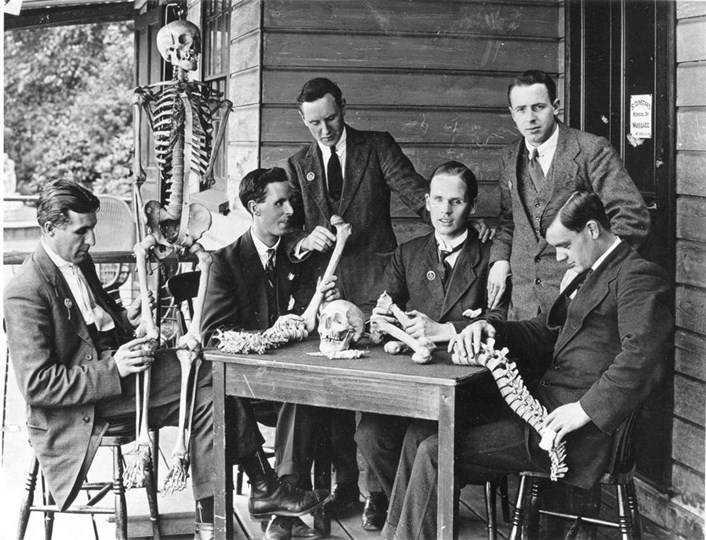2019 marks the centenary of the first ever physiotherapy special interest group.
The Association of Blind Certified Masseurs (changed in 1953 to The Association of Blind Chartered Physiotherapists), was formed by the Chartered Society of Physiotherapy, then the Incorporated Society of Trained Masseuses (ISTM), in 1919 in response to three overlapping concerns.
The first was the growing pressure on physiotherapists to train men. The Society of Trained Masseuses (STM) had been a profession run by women for women, from its inception in 1894 until the outbreak of World War I. But social anxieties over intimate physical contact between women and men were relaxing, and there was growing pressure on the ISTM to reform.
Many men were also returning from war with disabling injuries, and the new rehabilitation movement was advocating for these men to be gainfully employed. Blind masseurs had been recognized for many years,¹ but not as certified physiotherapists.
And thirdly, blind masseurs had proven themselves to be safe and more than comparable therapists.
Blind masseurs began to gain recognition in 1900 when the London (later ‘National’) School of Massage began accepting blind students for training under Dr. Fletcher Little (Barclay 1994, p.45). And in 1910 three graduates from Dr. Little’s school successfully passed the ISTM’s entrance exam.
In 1919, Percy Linney Way was co-opted onto the ISTM Council. Wray had been the founder of the National Institute for the Blind School of Massage, and his advocacy did a great deal to promote the view that the ‘presence of blind physiotherapists in the workforce demonstrate[d] physiotherapy’s ability to accommodate the absence of vision and its dependence on the sensations experienced/produced through its hands’ (Owen 2014, p.176).
Other Commonwealth countries relied heavily on services provided by the ISTM after the war, with the rehabilitation centre created from the converted mansion at St. Dunstan in London serving as a central training institute for students and teachers (Bentley 2006, pp.62-3; Shaw 2013, 66-8).²
The incorporation of blind practitioners into the physiotherapy profession has not been without its challenges, however. The fact that a new group of therapists had entered the profession, and that these were both men and blind caused consternation to many (French 1995, p.8). In the early years of the 20th century, ‘it was still considered unseemly for women to teach men anything involving physical contact’ (ibid).
Visual impaired therapists and disabled practitioners collectively have continued to face prejudice and discrimination however. It was only in 1956 that British trained physiotherapists were allowed to sit the same examination, and the CSP continued to register members as visually impaired until 1988 (ibid, p.10).
Despite this;
The physiotherapy school for visually impaired students is the only example in Great Britain of an institute of higher education catering specifically for disabled people. It is also the only school of physiotherapy in the world to offer a comprehensive training for visually impaired people leading to a qualification of parity with their sighted peers (Annual Report RNIB, 1978, cited in French 1995, p.16).
There is much to celebrate then about the centenary of the formation of physiotherapy’s first special interest group. But there are also important lessons here about the ongoing struggle of all disabled people to find a place in the profession.
References
Barclay, J. (1994). In Good Hands: The History of the Chartered Society of Physiotherapy 1894-1994. Oxford: Butterworth Heinemann.
Bentley, P 2006 The Path to Professionalism: Physiotherapy in Australia to the 1980s. Melbourne: Australian Physiotherapy Association.
French S (1995) Visually impaired physiotherapists: their struggle for acceptance and survival. Disability & Society 10(1)3-20.
Murphy, W. (1995). Healing the Generations: A History of Physical Therapy and the American Physical Therapy Association. Lyme, Connecticut: Greenwich Publishing.
Owen, G. (2014). Becoming a practice profession: A genealogy of physiotherapy’s moving/touching practice. PhD Thesis. University of Cardiff, Cardiff.
Shaw, L. (2013). In our hands: 100 years of the School of Physiotherapy in Otago 1913-2013. Dunedin: University of Otago.
Way PL (1950) Blind Physiotherapists: the struggle for acceptance. Edited version published in Physiotherapy 80(A)33A-35A.
Notes
¹ Jean Barcley suggests that the British and Foreign Blind Association referenced blind masseurs as early as 1891 (Barclay 1994, p.45). And Louise Shaw argues that Amelia Creighton Hale – a strong influence on massage education in the late 19th century – was teaching blind pupils in London in the 1890s (Shaw 2013, p.66).
² Oddly, Wendy Murphy makes no mention of training for blind American Physical therapists in her book Healing the Generations.

